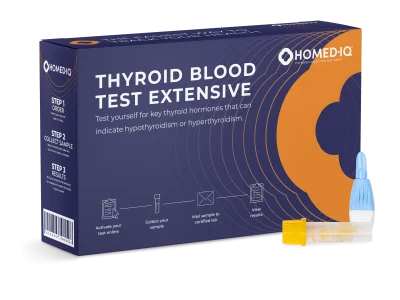Headaches are an extremely common condition that almost everyone suffers from at one point. There are many different types of headaches with different triggers, such as tension headaches, sinus headaches, and migraines. The cause of many headaches is not clear, which can leave people who experience them regularly searching for clues as to what triggers them. While headaches can be caused by numerous different factors, your thyroid function could play a role. In this article, we discuss the connection between thyroid problems and headaches, as well as explaining potential treatment and testing options. The thyroid blood test of Homed-IQ allows you to measure important indicators of thyroid health from home.
What is the thyroid gland?
The thyroid is a butterfly-shaped organ located in the neck. The thyroid produces hormones and releases them into the blood. These hormones are triiodothyronine (T3) and thyroxine (T4). Thyroid hormones are hugely important to your body; they regulate many processes including metabolism, digestion, brain function, and bone health. Both an overactive thyroid (hyperthyroidism) and underactive thyroid (hypothyroidism) are common health problems that can affect nearly all body systems.
How can the thyroid gland cause headaches?
Do you have frequent headaches? The health of your thyroid may play a role in this. Hypothyroidism, or an underactive thyroid, is associated with headache, particularly migraines. Meta-analysis of several studies on the topic suggest that there is a bi-directional relationship between hypothyroidism and headaches, meaning people who are more prone to headaches or migraines are more likely to have hypothyroidism, and having hypothyroidism may contribute to more frequent headaches or migraines (Spanou et. al, 2019). The link between headaches and hypothyroidism is still being studied, and more research is needed to completely understand the link.
What causes hypothyroidism?
Hypothyroidism occurs when the thyroid either does not make enough T3 and T4 (primary hypothyroidism) or the pituitary gland in the brain does not release enough thyroid stimulating hormone (TSH), the hormone that directs the thyroid to produce T3/T4. Hypothyroidism can have several causes, including
- Thyroiditis
- Use of certain medications
- Autoimmune diseases, such as Hashimoto’s disease.
- Tumors affecting the pituitary gland
- Removal of the thyroid
- Radiation treatment of the thyroid
- Congenital hypothyroidism (hypothyroidism that is present from birth)
Source: NIDDK, 2021
What are symptoms of an underactive thyroid?
The symptoms of hypothyroidism occur gradually and can vary from person to person. While the thyroid is primarily involved in metabolism, problems with the thyroid can cause symptoms that affect the entire body. Symptoms of hypothyroidism may include:
- Weight gain
- Trouble with concentration or memory
- Fatigue
- Sensitivity to cold
- Hair loss or dry skin
- Muscle and joint pain
- Irregular menstrual periods or fertility problems
Source: NIDDK, 2021
Although studies suggest an association between hypothyroidism and headaches, experts do not yet fully understand the mechanism of how this occurs or which causes the other. However, the International Headache Society estimates that approximately 30% of people with an underactive thyroid have headaches attributed to hypothyroidism (IHC, 2021).
How is an underactive thyroid treated?
Hypothyroidism is easily treated with hormone replacement medications that can relieve the symptoms associated with an underactive thyroid. If you suspect that your headaches may be linked to thyroid health, it is important to check your thyroid hormones. A blood test for thyroid hormones is the most reliable way to check for hyper- and hypothyroidism. This can be performed with your GP or using a home test. Once hypothyroidism is detected, your doctor can further investigate the cause and treatment options.
There are also lifestyle changes you can make to improve thyroid function, such as eating foods high in selenium and vitamin B12. Sources of selenium include tuna, shrimp, sardines, Brazil nuts and steak (Harvard Health, 2023). Sources of vitamin B12 include salmon, milk, cheese, beef, and eggs (NHS, 2022)
When should you check your thyroid levels?
Do you suspect that you have thyroid problems or are you experiencing symptoms that could indicate a thyroid issue? Gain clarity by checking the level of thyroid hormones in your blood. You can easily check your thyroid values at your GP or using Homed-IQ’s Thyroid Blood Test. This test is easy to take at home and measures the level of free T3, T4 and TSH in your blood. Your test will be examined by a certified laboratory and you will receive your test results within a few days.
-

Thyroid Blood Test Extensive
€69,00
In short, there is a possible link between hypothyroidism and headaches. However, it is not yet entirely clear whether hypothyroidism causes headaches, or whether headaches are a risk factor for hypothyroidism. If you have frequent headaches, it’s recommended to speak to your doctor about potential causes, testing, and treatments.
References
Harvard Health. (2023, March 7). Selenium. The Nutrition Source. https://www.hsph.harvard.edu/nutritionsource/selenium/#:~:text=Seafood%2C%20organ%20meats%2C%20and%20Brazil,%2C%20red%20meat%2C%20and%20eggs
NHS. (2022, May 26). B vitamins and folic acid. nhs.uk. https://www.nhs.uk/conditions/vitamins-and-minerals/vitamin-b/
NIDDK. (2021). Hypothyroidism (Underactive Thyroid). National Institute of Diabetes and Digestive and Kidney Diseases. https://www.niddk.nih.gov/health-information/endocrine-diseases/hypothyroidism
Spanou, I., Bougea, A., Liakakis, G., Rizonaki, K., Anagnostou, E., Duntas, L. H., & Kararizou, E. (2019). Relationship of Migraine and Tension‐Type Headache With Hypothyroidism: A Literature Review. Headache, 59(8), 1174–1186. https://doi.org/10.1111/head.13600
The International Classification of Headache Disorders, 3rd edition (beta version). (2013). Cephalalgia, 33(9), 629–808. https://doi.org/10.1177/0333102413485658





